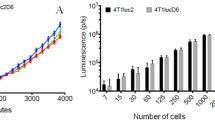Abstract
The gene encoding firefly luciferase has been used as a reporter gene for the study of gene function. The luciferase catalyzes its substrate and subsequently produces luminescence. In addition, it is not present in mammalian cells. We have therefore explored its use in monitoring the growth of tumorsin vivo. The luciferase gene was transfected into two murine tumor lines, i.e. cl62 melanoma and M109 lung carcinoma, and the luciferase activity associated with the cells was determined by a rapid chemiluminescent reaction. Luciferase activity was well-correlated with the number of tumor cellsin vitro. Luciferase activity also correlated with the tumor burdenin vivo, as well as with the effect of an adoptive T cell transfer therapy in the syngeneic C3H/HeN mice experimental tumor model. This assay offers the advantage of being quantitative, rapid, and reliable for the detection of tumor burden and for the evaluation of the effect of antineoplastic therapy.
Similar content being viewed by others
References
Morikawa K, Walker SM, Nakajima Met al. Influence of organ environment on the growth, selection, and metastasis of human colon carcinoma cells in nude mice.Cancer Res 1988,48, 6863–71.
Lin WC, Pretlow TP, Pretlow II TGet al. Bacterial LacZ gene as a highly sensitive marker to detect micrometastasis formation during tumor progression.Cancer Res 1990,50, 2808–17.
Zeidman I, McCutcheon M and Coman DR. Factors affecting the number of tumor metastasis experiments with a transplantable mouse tumor.Cancer Res 1950,10, 357–61.
Rose WC. Evaluation of Madison 109 lung carcinomas as a model for screening antitumor drug.Cancer Treat Rep 1981,65, 299–312.
Alam J and Cook JL. Reporter genes: application to the study of mammalian gene transcription.Analyt Biochem 1990,188, 245–54.
Gould SJ and Subramani S. Firefly luciferase as a tool in molecular and cell biology.Analyt Biochem 1988,175, 5–13.
Kricka LJ. Clinical and biochemical applications of luciferase and luciferins.Analyt Biochem 1988,175, 14–21.
Estin CD, Stevenson US, Kahn Met al. Transfected mouse melanoma lines expressing varying levels of human melanoma-associated antigen p97.JNCI 1989,81, 445–8.
Marks TA, Woodman RJ, Geran RIet al. Characterization and responsiveness of the Madison 109 lung carcinoma to various antitumor agents.Cancer Treat Rep 1977,61, 1459–70.
Kahn M, Sugawara H, McGowan Pet al. CD4+T cell clones specific for the human p97 melanoma-associated antigen can eradicate pulmonary metastases from a murine tumor expressing the p97 antigen.J. Immunol 1991,146, 3235–41.
Chen L, Ashe S, Brady WAet al. Costimulation of antitumor immunity by the B7 counterreceptor for the T lymphocyte molecules CD28 and CTLA-4.Cell 1992,71, 1093–1102.
Chen L, Ashe S, Singhal MCet al. Metastatic conversion of cells by expression of human papillomavirus type 16 E6 and E7 genes.Proc Nat Acad Sci USA 1993,90, 6523–7.
Gatt S and Rapoport MM. Isolation ofΒ-galactosidase from the brain.Biochim Biophys Acta 1966,113, 567–76.
Lederberg J. TheΒ-galactosidase ofEscherichia coli, strain K-12.Genetics 1950,35, 381–92.
Shimohama S, Rosenberg MB, Fagan AMet al. Grafting genetically modified cells into the rat brain: characteristics ofE. coli Β-galactosidase as a reporter gene.Mol Brain Res 1989,5, 271–8.
Denburg JL and McElroy WD. Catalytic subunit in firely luciferase.Biochemistry 1970,9, 4619–24.
Author information
Authors and Affiliations
Rights and permissions
About this article
Cite this article
Zhang, L., Hellström, K.E. & Chen, L. Luciferase activity as a marker of tumor burden and as an indicator of tumor response to antineoplastic therapyin vivo . Clin Exp Metast 12, 87–92 (1994). https://doi.org/10.1007/BF01753974
Received:
Accepted:
Issue Date:
DOI: https://doi.org/10.1007/BF01753974




